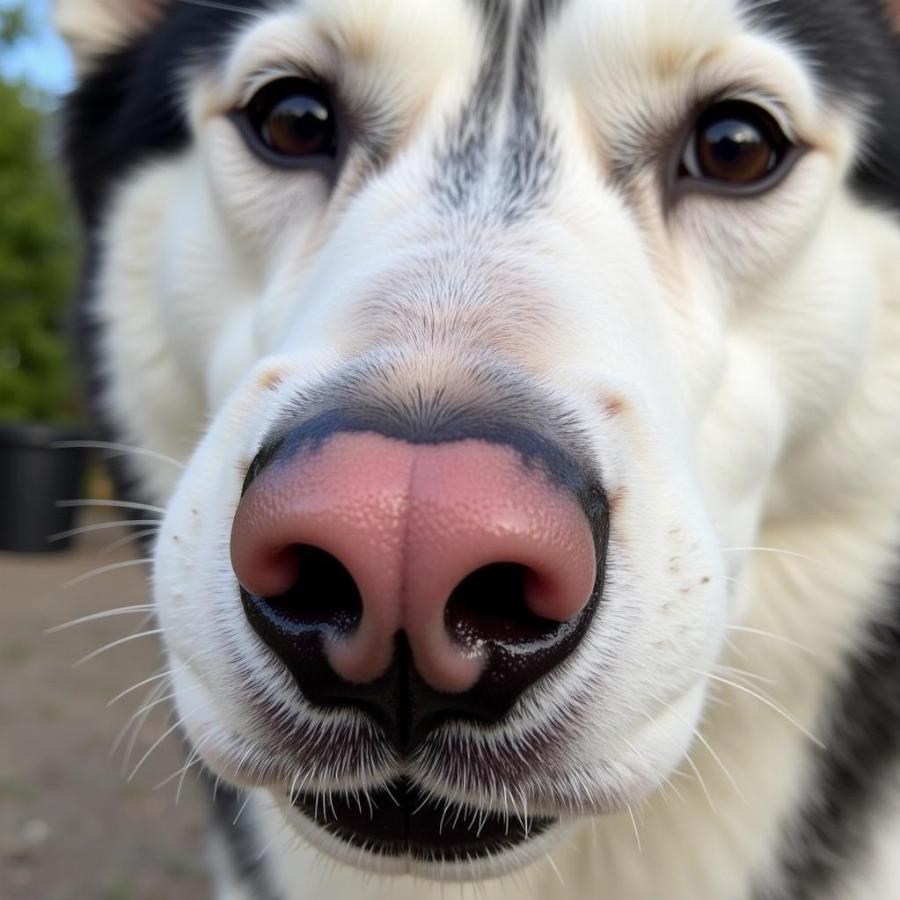A dog’s pink nose can be a charming feature, a sign of a specific breed, or sometimes, an indication of an underlying health issue. Understanding the reasons behind a dog’s pink nose is essential for every responsible owner. This article delves into the various factors contributing to a dog pink nose, helping you discern between natural variations and potential health concerns. From breed-specific traits to environmental influences and health conditions, we’ll cover everything you need to know about that adorable pink snout.
Decoding the Dog Pink Nose: Breed-Specific Traits
Many breeds naturally sport a pink nose, often referred to as a “Dudley nose.” Breeds like the Siberian Husky, Samoyed, and Labrador Retriever can have a Dudley nose either permanently or temporarily due to seasonal changes. This genetic trait causes a lack of pigment, resulting in a light pink or flesh-colored nose. Is your dog one of these breeds? If so, a pink nose is likely perfectly normal.
 Chó Cảnh Mũi Hồng Giống Husky
Chó Cảnh Mũi Hồng Giống Husky
When the Seasons Change: Why is My Dog’s Nose Turning Pink?
One fascinating phenomenon is “snow nose” or “winter nose,” where a dog’s normally dark nose fades to pink during colder months. This temporary change in pigmentation is thought to be related to reduced sunlight exposure and enzyme activity. why is my dogs nose turning pink The nose typically returns to its original color as the weather warms up. Have you noticed your dog’s nose changing color with the seasons?
Understanding Winter Nose: A Temporary Transformation
The exact mechanisms behind winter nose aren’t fully understood, but it’s generally considered harmless. While a pink nose in winter might raise concerns, it’s often a natural adaptation and nothing to worry about. Does your dog’s nose return to its normal color in the warmer months?
Health Concerns: When a Pink Nose Signals a Problem
While a pink nose is often benign, it can sometimes indicate underlying health problems. Conditions like lupus, allergies, and certain infections can cause changes in nose pigmentation. why is my dog's nose turning pink If you notice other symptoms alongside a change in nose color, such as dryness, cracking, sores, or discharge, consult your veterinarian immediately. Is your dog exhibiting any other unusual symptoms?
Identifying Potential Health Issues: Is Your Dog’s Nose Pink and Dry?
A pink and dry nose, accompanied by other symptoms, can be a red flag. Don’t hesitate to seek professional advice if you’re concerned about your dog’s health. dogs nose pink Early detection and treatment are crucial for managing any potential health issues.
Living with a Pink-Nosed Pup: Care and Considerations
Whether your dog’s pink nose is a breed trait, seasonal change, or a sign of something else, proper care is vital. Protecting the nose from sun damage is crucial, especially for dogs with light-colored noses. Use a pet-safe sunscreen on the nose during sunny days to prevent sunburn. dogs with pink nose Have you considered sun protection for your pink-nosed companion?
Conclusion: Embracing the Pink Nose Charm
A dog pink nose can be a charming characteristic, a seasonal quirk, or a potential health indicator. By understanding the various factors that contribute to a pink nose, you can provide the best possible care for your furry friend. Remember to observe your dog for any other symptoms and consult your veterinarian if you have any concerns. dog's nose is pink Embrace the uniqueness of your dog’s pink nose and prioritize their overall health and well-being.
FAQ: Common Questions About Dog Pink Noses
- Is a pink nose always a sign of a health problem? No, a pink nose can be a natural breed trait or a temporary change due to the weather.
- How can I tell if my dog’s pink nose is a cause for concern? Look for other symptoms like dryness, cracking, sores, or discharge.
- What should I do if my dog’s nose suddenly turns pink? Monitor for other symptoms and consult your veterinarian if you’re concerned.
- Can a dog’s pink nose turn dark again? Yes, in cases of winter nose, the color often returns in warmer months.
- How can I protect my dog’s pink nose from the sun? Use a pet-safe sunscreen on the nose during sunny days.
- Are certain breeds more prone to pink noses? Yes, breeds like Huskies, Samoyeds, and Labradors are more likely to have a Dudley nose.
- What is a Dudley nose? A Dudley nose is a genetically determined lack of pigment in the nose, resulting in a pink or flesh-colored appearance.
Beaut Dogs is your trusted resource for all things dog-related. We offer comprehensive information on dog breeds, care, and everything in between. For personalized advice and answers to your specific questions, contact us at Email: [email protected]. Beaut Dogs is dedicated to helping you provide the best possible care for your canine companion. Visit us at https://beautdogs.com to learn more.